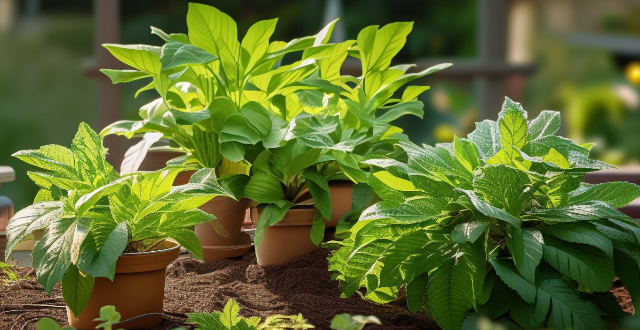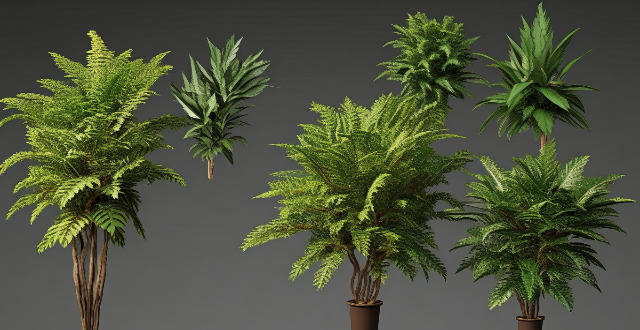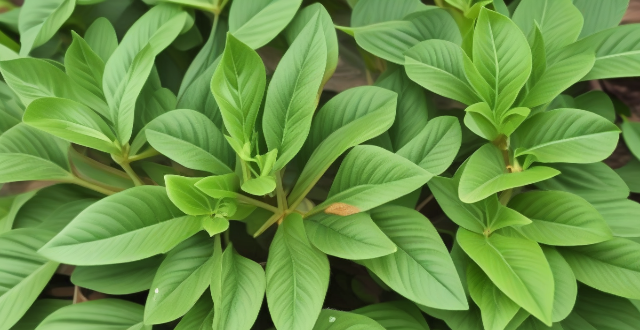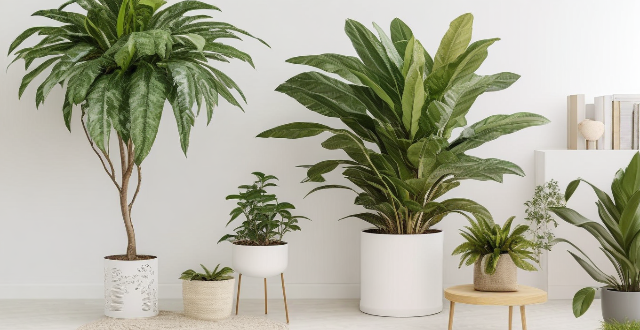Grow Plant

What is the ideal temperature for indoor plant growth ?
Indoor plants generally thrive in temperatures between 65°F to 75°F during the day and slightly cooler at night, along with proper humidity and air circulation. Maintaining these conditions helps promote healthy growth and flowering. Use a thermometer, avoid drafts, and adjust heating or cooling as needed to keep plants comfortable.

How can I revive a dying indoor plant ?
Reviving a dying indoor plant requires patience, care, and attention to detail. Here are some steps you can take to help your plant recover: Identify the problem, adjust watering schedule, provide adequate sunlight, fertilize appropriately, prune dead leaves and stems, repot if needed, monitor for pests and diseases, maintain humidity levels. By following these steps and providing regular care and attention, you can revive a dying indoor plant and help it thrive once again.

Why are the leaves of my indoor plant turning yellow ?
Yellowing leaves on indoor plants can indicate various issues, including improper watering, nutrient imbalances, unsuitable lighting, temperature stress, pest infestations, diseases, physical damage, or natural aging. Addressing these concerns involves adjusting watering habits, providing adequate light, using appropriate fertilizers, maintaining ideal temperatures, monitoring for pests and diseases, handling plants gently, and regular pruning. Understanding and responding to these factors can help restore the plant's health and prevent future leaf discoloration.

What are the best indoor plants for low-light conditions ?
The best indoor plants for low-light conditions include Pothos, Snake Plant, Philodendron, Peace Lily, and ZZ Plant. These plants are adaptable, easy to care for, and known for their ability to purify the air. They come in various sizes and shapes, making them suitable for different preferences and spaces.

Is hiring a financial advisor worth it for someone looking to grow their wealth ?
Hiring a financial advisor can be beneficial for individuals seeking to grow their wealth, especially if they have complex financial situations or limited knowledge of personal finance. Financial advisors provide professional expertise, customized financial plans, time-saving convenience, objective advice, and ongoing support to help clients achieve their financial goals. However, the decision to hire a financial advisor should be based on individual needs and circumstances.

How can I incorporate more plant-based meals into my family's diet ?
Incorporating more plant-based meals into your family's diet can lead to improved health, weight management, and a reduced environmental impact. Here's how to do it: 1. **Understand the Benefits**: Improved health, weight management, and environmental sustainability are key advantages of a plant-based diet. 2. **Gradual Transition**: Start by replacing one or two meals per week with plant-based options to ease your family into the change. 3. **Meal Ideas**: Try Meatless Mondays, vegetable-centric dinners, and incorporating plant-based proteins like tofu and beans. 4. **Involve Your Family**: Get your family excited about the change by letting them choose recipes and shop for ingredients. 5. **Shopping Tips**: Buy fresh produce, stock up on staples like grains and legumes, and experiment with new foods. 6. **Education and Resources**: Use online resources like websites, YouTube channels, and cookbooks to learn about plant-based eating. 7. **Meal Planning and Preparation**: Plan weekly meals, consider batch cooking, and get creative with leftovers. 8. **Emphasize Flavor and Creativity**: Use herbs, spices, marinades, and sauces to add flavor, and don't be afraid to experiment with different cooking techniques.

How much sunlight do indoor plants need ?
Indoor plants require sunlight for photosynthesis, but the amount needed varies by species. General guidelines include low light tolerance for plants like Peace Lily and Snake Plant, medium light requirements for Dracaena and Pothos, and high light preference for Cacti and Succulents. Key considerations involve window orientation and artificial lighting. Success tips include researching plant needs, monitoring response, and gradual adjustment to new lighting conditions.

Can you recommend any air-purifying indoor plants ?
Sure, here are some air-purifying indoor plants that I recommend: # 1. Snake Plant (Sansevieria trifasciata) The Snake Plant is a popular choice for its ability to absorb toxins like formaldehyde and benzene from the air. It's also very low maintenance and can thrive in low light conditions. # 2. Spider Plant (Chlorophytum comosum) The Spider Plant is known for its long, spider-like leaves and ability to remove harmful chemicals like xylene and formaldehyde from the air. It's also easy to care for and can grow in a variety of lighting conditions. # 3. Peace Lily (Spathiphyllum wallisii) The Peace Lily is a beautiful plant that not only adds aesthetic value to your home but also helps to purify the air by removing toxins like ammonia, benzene, formaldehyde, and trichloroethylene. It prefers low to medium light and should be kept moist but not waterlogged. # 4. English Ivy (Hedera helix) English Ivy is a versatile plant that can be grown as a ground cover or trained to climb walls. It's effective at removing airborne toxins like formaldehyde, benzene, and carbon monoxide. However, it requires moderate to high light and regular watering. # 5. Bamboo Palm (Chamaedorea seifrizii) The Bamboo Palm is a tropical plant that can help filter out formaldehyde, benzene, and trichloroethylene from the air. It prefers bright, indirect light and should be kept moist but not waterlogged. # 6. Rubber Plant (Ficus elastica) The Rubber Plant is known for its large, glossy leaves and ability to remove toxins like formaldehyde from the air. It prefers bright, indirect light and should be watered when the top inch of soil is dry. # 7. Golden Pothos (Epipremnum aureum) Golden Pothos is a trailing plant that can be grown in a hanging basket or trained to climb walls. It's effective at removing toxins like formaldehyde, benzene, and xylene from the air. It prefers bright, indirect light and should be kept moist but not waterlogged. # 8. Aloe Vera (Aloe barbadensis) Aloe Vera is a succulent plant that's known for its healing properties and ability to remove formaldehyde from the air. It prefers bright, direct light and should be watered once the soil is completely dry. # 9. Boston Fern (Nephrolepis exaltata) Boston Fern is a lush, green fern that can help purify the air by removing toxins like formaldehyde and xylene. It prefers high humidity and should be kept moist but not waterlogged. # 10. Chinese Evergreen (Aglaonema modestum) Chinese Evergreen is a low-maintenance plant that can help remove toxins like benzene and formaldehyde from the air. It prefers low to medium light and should be kept moist but not waterlogged.

Should I use fertilizer for my indoor plants, and if so, how often ?
Fertilization is crucial for indoor plants, providing essential nutrients for growth. The need for fertilizer depends on factors like plant type, soil quality, and light exposure. Most indoor plants benefit from monthly fertilization during the growing season, while slow-growing plants may need it less frequently. Signs of nutrient deficiency can guide adjustments to the fertilization schedule. Choosing the right fertilizer involves considering its type (synthetic or organic) and NPK ratio. Proper application includes diluting the fertilizer, watering beforehand, and avoiding direct contact with leaves and stem. Balancing nutrients and care ensures healthy plant growth without the risks of over-fertilization.

How do I choose the right pot for my indoor plants ?
Choosing the right pot for indoor plants is crucial for their growth and development. Consider factors like plant size, drainage needs, material, style, and maintenance when selecting a pot. Ensure proper drainage to prevent root rot, choose materials that suit your plant's needs and your home's style, and be prepared for the care requirements of different pot types.

What are the benefits of a plant-based diet for women ?
A plant-based diet offers numerous health benefits for women, including improved cardiovascular health, weight management, cancer prevention, bone health, reproductive health, digestive health, skin health, and mental wellbeing. It is important to consult with a healthcare professional or registered dietitian when making significant dietary changes.

What are some strategies for eating a more plant-based diet ?
Strategies for eating a more plant-based diet include embracing whole foods, experimenting with alternative proteins, getting creative with meal planning, learning about nutritional balance, educating yourself, supporting sustainable practices, and connecting with others. These steps can help you transition to a healthier and environmentally friendly way of eating while ensuring you receive all the necessary nutrients.

Are there any indoor plants that are safe for pets ?
Indoor plants can be a great addition to any home, but it's important to choose ones that are safe for pets. Here are some options: 1. Spider Plant 2. Boston Fern 3. Peace Lily 4. Bamboo Palm 5. Christmas Cactus 6. Rubber Plant 7. Ponytail Palm 8. Friendship Plant 9. Parlor Palm 10. Heartleaf Philodendron

How to grow haemorrhoid to return a responsibility after pregnancy_ How to grow haemorrhoid to return a responsibility after pregnancy

How do I prevent pests from infesting my indoor plants ?
To prevent pests from infesting your indoor plants, maintain proper hygiene, optimize growing conditions, utilize natural repellents and treatments, try physical removal methods, consider biological control, and use chemical control as a last resort. Regular plant inspection is also key for early detection of potential problems.